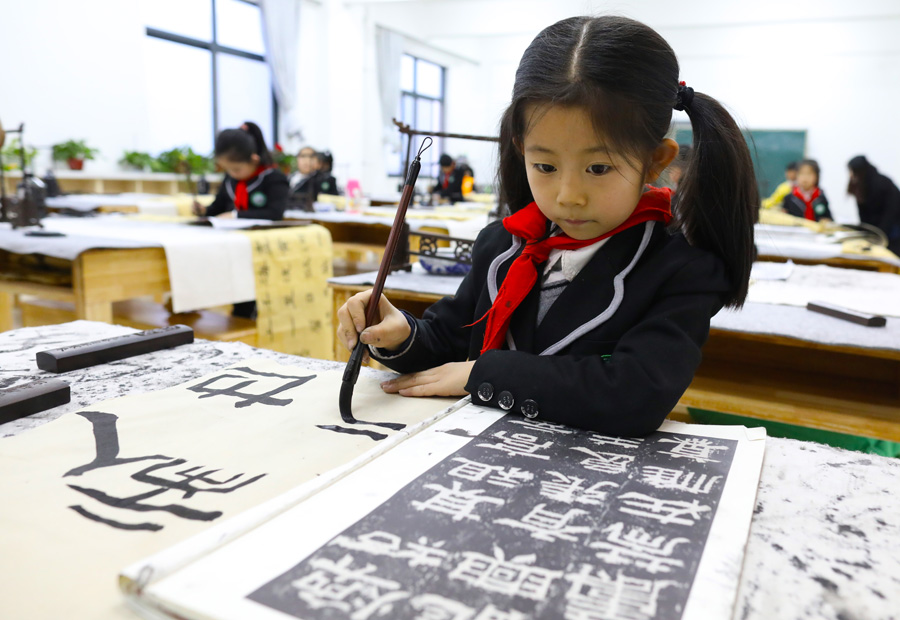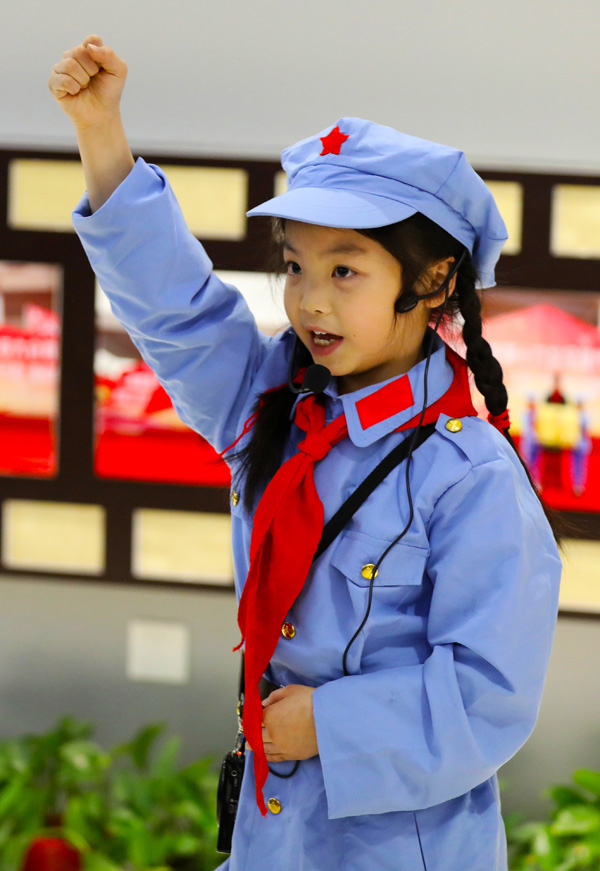Women offer paper cuttings for sale in Yan'an, Shaanxi province. ZHU XINGXIN/CHINA DAILY
One of the country's best-loved cities is flourishing thanks to fruitful policies, as Zhang Zhihao reports from Yan'an, Shaanxi.
Yan'an, Shaanxi province, is probably the most revered city in China. According to legend, the Yellow Emperor planted a cypress tree near the remote settlement 5,000 years ago to mark the formation of the Huaxia, the ethnic group from which the Han Chinese trace their origins.
Locals say the tree is still growing in Huangling county.
Yan'an was also the cradle of the Chinese revolution after the Red Army took up residence in the city at the end of the 12,500-kilometer Long March in October 1935.
For the next 13 years, the leaders of the Communist Party of China lived in cold, flea-infested caves while they laid down the blueprint for the People's Republic of China by testing new policies, holding seminal meetings and regaining military strength.
Yan'an's strategic location at the intersection of three mountains on the Loess Plateau meant it was a highly contested military outpost as early as the Warring States Period (475-221 BC). As a result, it saw countless battles, poverty, migration and environmental degradation for hundreds of years.
Things have improved in the past two decades thanks to a program called "Grain for Green", which has transformed the barren environment into a lush paradise with new industries based on agricultural and natural resources.
Meanwhile, poverty alleviation programs have allowed the locals to abandon old, ineffective agricultural methods in favor of higher paying, less labor-intensive work, and they can now live without worrying that bad weather will destroy their livelihoods.
"Yan'an is the cradle of the nation and the soul of all reforms," said Ke Changwan, director of the Yan'an Publicity Department.
"The hardworking, optimistic, innovative and courageous spirit of the people has ensured the city's success and will continue to motivate the nation in the future."
A student at Beijing No 2 Experimental Primary School in Yan'an practices calligraphy. ZHU XINGXIN/CHINA DAILY
Tree of life
Lin Zhihai, 60, of Caoyangtai village, Wuqi county, is looking forward to harvesting his first batch of apples later this year.
In 2014, the local government began subsidizing farmers who planted apple trees as a means of expanding the area covered by orchards, reducing soil loss and raising incomes.
After three years of hard work, Lin's trees, mostly the Fuji hybrid, have finally matured and are ready to bear fruit. He planted around 0.6 hectare of trees, and expects to make between 40,000 yuan and 60,000 yuan ($6,330 and $9,494) this year, in addition to the money he makes from growing almonds and peaches.
"In previous years, we could only earn about 2,000 yuan a year by planting corn. We had to work day in and day out and hope bad weather would not destroy our crops," he said.
"Growing apples is very easy because the government subsidizes the seeds and fertilizer, and also trains us to cultivate the trees."
Lin has lived in Yan'an all his life, which means he has witnessed how "the mountains changed from barren to green".
"When I was about 8 years old, I was a shepherd, and our sheep would eat the sparse vegetation that grew in the valley," he said. "Every time the wind blew, sand and dirt would blow in my face. We loved singing while herding, but we could not even open our mouths."
Since 1999, the government has intensified efforts to transform farmland into forests in an effort to restore the environment on the Loess Plateau and reduce flooding along the lower reaches of the Yellow River. By 2016, the policies had created more than 718,000 hectares of woodland in Yan'an, and by last year, about 68 percent of the city was covered with greenery.
"This has changed our lives dramatically," said Lin, who lives with his wife and mother in a large house in the village and drives a minivan.
"We used to plant crops because we had nothing to eat. Now, we don't worry about food because we can earn much more by planting trees and selling the produce, and I can use the extra money to buy food. The apple trees will make my life even better."
A young girl in a red army uniform acts out a story from history. ZHU XINGXIN/CHINA DAILY
Cultural heritage
Every weekday, Liu Ruiqi, a fifth grade student at the Yan'an campus of Beijing No 2 Experimental Primary School, walks through the school's "Hall of Culture" to her classroom, whose ceiling is covered with small banners bearing classic Chinese teachings and virtues.
The walls on both sides are full of the students' paintings of famous Chinese heroes who stayed in Yan'an, ranging from Meng Tian, a general during the Qin Dynasty (221-206 BC), to Du Fu, a poet of the Tang Dynasty (618-907).
"Classical teachings are everywhere-they help us learn and remind us to be good children," Liu said.
During recess, the students like to navigate a maze in the cultural play zone. The maze is called the "Long March", and at certain key corners there are texts about important facts or locations during the march.
"When we are running through the maze, we can learn about the Long March and its history," Zhou Zixuan, 10, said. "The maze is easy, but the real march must have been very, very hard. It makes me appreciate what our forefathers went through even more."
Wang Hongxia, the principal, said the school was designed to "immerse young students in classic culture and the history of the Chinese Revolution, while studying the typical elementary curriculum".
While some children learn to appreciate Yan'an's culture at school, others are dedicated to arts and crafts from an early age. The two most famous and popular local art forms are paper cutting and waist drum dancing, both of which are listed as world protected cultural heritages by the UN.
According to The Encyclopedia of Chinese Folklore and Classic Traditions, they are believed to have originated some time before the sixth century BC as religious rites to honor gods, dispel evil spirits and celebrate the Lunar New Year.
However, the traditions are so old that many techniques have been lost down the ages. Those that survive are passed down through the generations.
That was the case for Yu Zeling, who was born in Yan'an's Ansai district, and began practicing paper cutting at the age of 12. The 52-year-old's work was featured at the Shaanxi Global Expo, organized by the Foreign Ministry, in 2016.
"The main characteristic of Yan'an paper cutting is simplicity and detail," she said. "I learned the craft from my aunt, who learned it from her parents. I am also passing it on to younger relatives."
Thanks to her mastery of the art form, Yu doesn't need to resort to agricultural labor. She earns more than 80,000 yuan a year, making her one of the richest people in her village. "Having money is great, but having more people learn and appreciate this art form is even better," she said.
According to Chen Jun, Party secretary of Dufuchuan community in Yan'an's Baota district, in addition to the extra money, classic arts and crafts are therapeutic and can make a community healthier and more peaceful.
In the past, low levels of education and a lack of things to do resulted in the local people gambling, drinking and bickering with their neighbors, she said. The situation has improved thanks to better management, stronger security and healthier hobbies.
The community has an art room where residents can practice calligraphy and other arts for free.
"The people of Yan'an love the local culture, but they often lack the necessary tools. Now, they can undertake much healthier hobbies," Chen said.
"A positive culture has brought cohesion to the community and made it a better place to live for everyone."



Agriculture and art renew 'cradle' of the nation
Editor:张焕勤
Source:中国日报
Updated:2018-01-30 15:07:20
Source:中国日报
Updated:2018-01-30 15:07:20
Special
Contact
Welcome to English Channel! Any suggestion, welcome.Tel:0731-82965627
lisl@rednet.cn
zhouqian@rednet.cn











